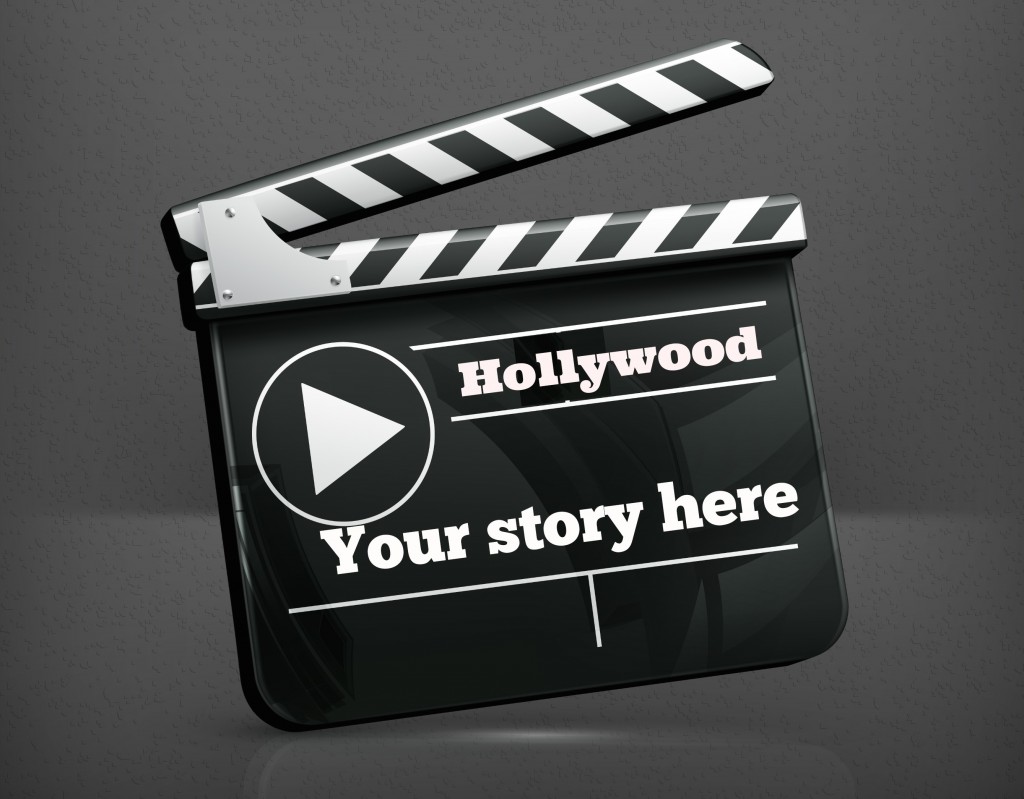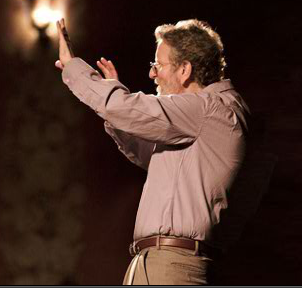
Do you hear “Lights! Camera! Action!” at your business presentations?
Maybe not. But do you think about “Conflict! Emotion! Transformation?” According to screenwriter and story consultant Michael Hauge, those elements can make your business stories start to rock.
He should know. Michael has consulted on story to directors, producers and super star actors like Will Smith. And he applies the ten components of story structure (see below) to our business narratives as well. I had an opportunity to hear him when he did a workshop for our local branch of the National Speakers Association.
Now if you think business communications should all be no nonsense, objective and non-emotional, his message may be confronting. Michael is emphatic:
“Emotion is the key to great stories.”
During his workshop, Michael coached four lucky speakers on how to sharpen their business stories. I listened to Michael’s suggestions – and they made sense:
- Be clear who the hero is – you or your client.
- Make us care about your hero.
- Heighten the danger – heighten the risk – and increase the emotional response from your audience.
- Give your story rich, specific details so that everyone can see and hear the world from the perspective of your hero. (And cut out the abstract images, generalizations and consultant or technical-speak!)
Here are some clips from Michael’s ten components of every great story:
THE HERO. Whoever is the hero in the story – we, our client, or someone else we describe – our audience must be able to identify and care about our hero if our story is going to work. Michael coached one speaker whose hero was a manager struggling with social media. “Show us the danger she’s in if she doesn’t get this right.” “Show us what’s at risk.” “Make us care.”
“Your audience wants to identify with your hero,” he said. “In fact, they want to become your hero on a psychological level.”
To accomplish that, you have to create EMPATHY. You can create empathy by showing the risks confronting your hero, showing the losses s/he has faced or making her/him a very sympathetic person.
Your story will usually start with the SET-UP – it’s the “before” picture. Let your audience know how life for your hero has been before the change launches her/him into new conflicts, risks and adventures. (Show us the boring old life of Clark Kent at the Daily Planet so that we can appreciate Superman.)
The story comes to action when OPPORTUNITY knocks. Something has to happen that has never happened before. This then creates some form of desire in the hero and shifts the story – taking him into a situation where he has never been before.
Next the hero needs to confront the NEW SITUATION and try to figure things out. There’s a dilemma. What to do? She begins to live in this new world, struggling, until a goal emerges – an OUTER MOTIVATION that will propel her into action.
This was an important element and one that Michael underscored. He said that the outer motivation is the one component of a story that is most often missed. Your audience needs to be able to picture, taste, or identify with the specific goal your hero is seeking. “Anyone who hears your story needs to be able to envision your hero crossing that finish line.” Hollywood stories give people a simple, easy to understand, clearly defined, endpoint. Don’t leave the finish line vague (and the goal needs to be tangible – not psychological.)
“The more specific, the more vivid…the more compelling.”
This piece of advice was challenging for me – because often I’m most interested in changes in my hero’s outlook or psychological state. I’ve resolved to make sure that the hero in my stories (including myself in the legend I’m living) are seeking tangible goals that an audience can relate to.
In coaching the four presenters, Michael wanted them to use specifics. In the story about a manager dealing with social media, he wanted to know how many LinkedIn contact requests did she actually received? How long would it typically take her to respond? What specifically would happen if she didn’t follow-up on her contacts? And exactly why or how did she change her behavior? Michael kept asking for specifics.
Vagueness and generality are the enemies of good story.
Story requires GROWING CONFLICT. “Story is only going to be involving if the pursuit of that goal is impossible” because “your goal is to create an emotional experience.”
“Emotion grows out of conflict not desire.”
The emotional moments in a film come when the hero encounters increasingly difficulty obstacles. “The bigger the conflict, the bigger the obstacles, the more emotional the story.”
In the climax of a story “whatever the desire is, whether the hero achieves it or fails, the desire must be completely resolved.” If the hero doesn’t win in our business stories, we can show 1) the cost of not winning (after they didn’t follow our advice) or 2) the learning/transformation that came from not-winning.
Finally, all stories need an AFTERMATH. Our last scene can’t be the climax. WE must show the new life the hero is living having completed the journey. (If it’s your clients, show us the life they are living as a result of your great work together.)
Michael didn’t talk much about the final element of TRANSFORMATION. But he said that if we want to inspire, we must reveal how our characters change internally when they meet the challenges of their journeys.
At the end of the workshop, Michael talked about applying of story to coaching and consulting. Change triggers fear. If you’re asking your audience to change, you can expect they will have fears and concerns because we all do, such as:
- The fear of taking risks
- The fear of what people will think of us
- The fear that we’re not good enough
- The concern about whether we’ll find the courage to do the right thing
- The concern about standing up for ourselves.
In creating a great story, you help people identify with the journey. When you show how your hero found courage, (as specifically as possible) you’re showing your audience how they can find courage as well.
He gave us so much to chew on. Now I want to revisit a few of my stories – because even if my name won’t be in lights, I still want to light up my audience.










